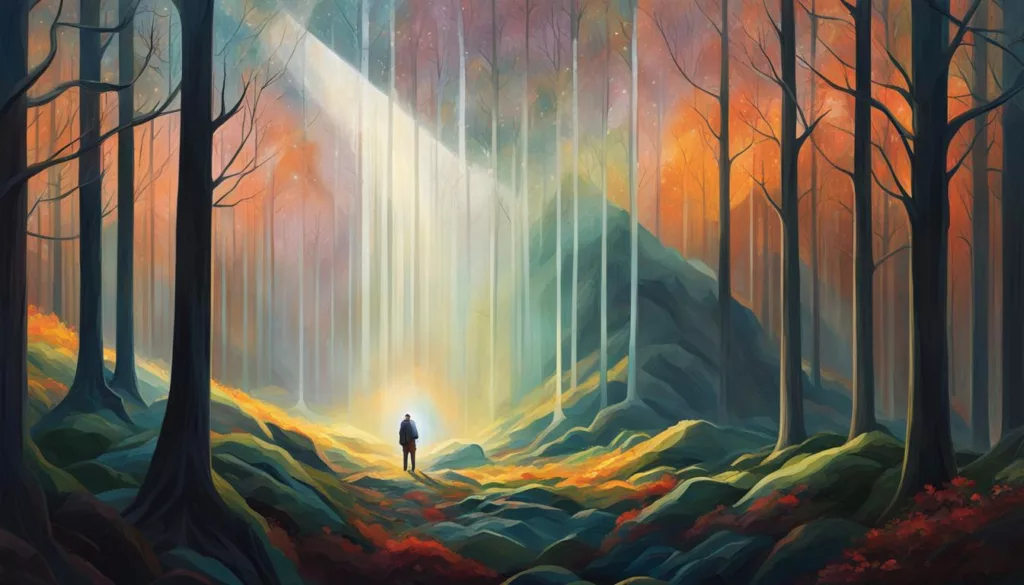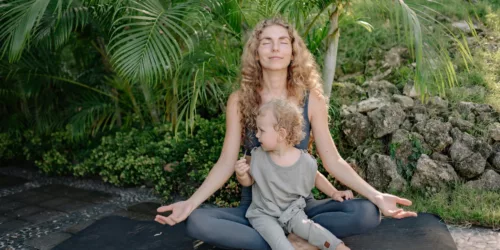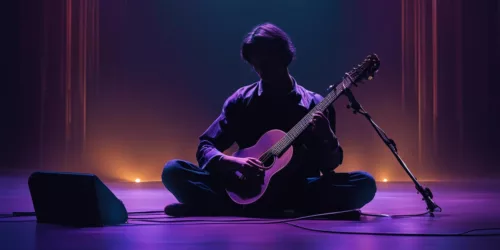Visualization Techniques for Artists to Boost Inspiration and Productivity
Welcome to a world of unlimited creativity and boundless possibilities! As an artist, you possess a unique gift – the power to transform your imagination into tangible works of art. But sometimes, finding inspiration and channeling your creative energy can be a daunting task. That’s where visualization techniques come in.
Visualization is a powerful tool that can fuel your artistic journey, boost your inspiration, and enhance your productivity. By harnessing the power of visualization, you can tap into your subconscious mind, unlock new ideas, and bring your artistic vision to life. Whether you’re a painter, sculptor, writer, or dancer, visualization can help you break through creative blocks and take your work to the next level.
But what exactly is visualization? It’s the process of creating vivid mental images or representations in your mind. When you visualize, you engage the same parts of your brain that are active when you experience something in real life. This powerful technique allows you to explore artistry beyond what meets the eye, igniting your imagination and fueling your creative fire.
So, how can visualization benefit artists like you? Firstly, it stimulates your subconscious mind, unlocking a wealth of untapped ideas and insights. By tapping into your subconscious, you can access a wellspring of inspiration that may have gone unnoticed. Secondly, visualization enhances your problem-solving skills. It provides a fresh perspective on artistic challenges, encouraging you to think outside the box and find innovative solutions. Lastly, visualization fosters a sense of innovation and originality. By exploring unconventional possibilities and breaking free from artistic conventions, you can push the boundaries of your creativity and produce truly groundbreaking work.
Ready to dive into the world of visualization? There are numerous techniques you can explore to harness its power. Consider using mind mapping, a visual organization tool that allows you to connect ideas and visually map out your creative process. You can also practice mental imagery, creating vivid mental pictures to enhance your artistic vision. Another technique is guided visualizations, where you follow scripted narratives or audio recordings to ignite your imagination and unlock fresh ideas.
By incorporating visualization into your daily artistic practice, you can reap the full benefits of this powerful technique. Set aside dedicated time for visualization exercises, treating it as a regular practice. Create vision boards to manifest your creative goals, and practice meditation to deepen your visualization experiences. Harness the power of affirmations and positive self-talk to reinforce your artistic vision and build confidence in your creative abilities.
Visualization is not limited to traditional art forms; it can also enhance improvisation and spontaneity for performers. By practicing creative visualization, performers can improve their memory, boost confidence, and increase motivation and enjoyment. Whether you’re a musician, actor, or dancer, visualization can help you unleash your full creative potential on stage.
Key Takeaways:
- Visualization is a powerful tool for artists to boost inspiration and productivity.
- Visualization stimulates the subconscious mind, enhances problem-solving skills, and fosters innovation.
- Techniques like mind mapping, mental imagery, and guided visualizations can be used to harness the power of visualization.
- Incorporate visualization into your daily artistic practice to unlock your creative potential.
- Performers can use creative visualization to enhance improvisation and spontaneity on stage.
Understanding Visualization
In this section, we will delve deeper into the concept of visualization and explore its significance in the creative process. Visualization involves the creation of vivid mental images or representations that play a crucial role in stimulating our imagination and bringing ideas to life.
Visualization works by engaging various regions of the brain, with the primary visual cortex being a key player in processing visual information. This region receives input from our eyes and helps us form mental images based on the data received. Additionally, other brain regions, such as the parietal lobe and the hippocampus, contribute to the creation and storage of visual representations.
Visualization serves as a powerful conduit for connecting our imaginative ideas with tangible forms. When we visualize, we activate similar brain regions as when we experience something in reality, strengthening the connection between our thoughts and their manifestation.
The connection between visualization and imagination is significant. Visualization allows us to tap into our imaginative faculties and explore limitless possibilities. It helps us envision alternative scenarios, hypothetical solutions, and innovative approaches. By visualizing our desired outcomes, we can better understand the steps needed to achieve them.
The Power of Visualization in Enhancing Creativity
Research suggests that visualization positively impacts creativity by enhancing cognitive processes related to problem-solving, idea generation, and innovation. It allows us to explore novel perspectives, think outside the box, and discover unique connections between seemingly unrelated concepts.
Visualizations enable us to engage our subconscious mind, where unconventional ideas and solutions often reside. By accessing this deeper level of thinking, we can tap into our intuitive insights and unlock hidden potentials. Visualization unleashes the power of our imagination, providing us with a pathway to express our creative vision.
To further illustrate the significance of visualization in enhancing creativity, consider the following table:
| Benefits of Visualization for Creativity | Explanation |
|---|---|
| Stimulates divergent thinking | Visualization encourages us to explore multiple possibilities, expanding our thinking beyond conventional boundaries. |
| Boosts problem-solving abilities | Visualizing complex problems helps us analyze different variables, identify patterns, and devise innovative solutions. |
| Fosters the generation of original ideas | Visualization allows us to tap into our unique perspective, facilitating the creation of fresh and groundbreaking concepts. |
| Enhances spatial reasoning | Visualizations require mental manipulation of space, improving our ability to understand and visualize objects in their context. |
| Archetype exploration | By visualizing archetypal images, such as heroes or mentors, we can draw upon their qualities to inspire our creative process. |
With a deep understanding of visualization and its connection to imagination and creativity, we can now explore the practical benefits of incorporating visualization techniques into our artistic endeavors. In the following section, we will delve into specific techniques that artists can employ to harness the power of visualization.
The Benefits of Visualization for Creativity
Visualization is a powerful technique that can significantly enhance your creativity. By harnessing the power of visualization, you can tap into untapped ideas and insights, develop problem-solving skills, and foster innovation and out-of-the-box thinking.
Stimulating the Subconscious Mind
One of the key benefits of visualization is its ability to stimulate the subconscious mind. When you visualize, you create vivid mental images that activate and engage your imagination. This process allows your mind to explore new possibilities and unearth hidden ideas that may not have surfaced otherwise. By accessing your subconscious mind through visualization, you can unlock a wealth of creative potential.
Enhancing Problem-Solving Skills
Visualization also plays a crucial role in enhancing problem-solving skills. When faced with complex problems, visualizing them can provide a fresh perspective and promote a visual and spatial understanding. By visualizing the problem, you can break it down into manageable parts, identify potential solutions, and explore different approaches. Visualization allows you to think beyond conventional limits and find innovative solutions to creative challenges.
Fostering Innovation and Out-of-the-Box Thinking
Another significant benefit of visualization is its ability to foster innovation and out-of-the-box thinking. By engaging your imagination and visualizing different scenarios or possibilities, you can break free from traditional constraints and explore unconventional ideas. Visualization encourages you to think beyond the expected and seek innovative solutions. When you embrace visualization as a tool for creative thinking, you open yourself up to new perspectives, experiences, and breakthrough ideas.
Now that you understand the benefits of visualization for creativity, it’s time to start incorporating this powerful technique into your creative practice. The following table summarizes the key advantages of visualization:
| Benefits of Visualization |
|---|
| Stimulates the subconscious mind |
| Enhances problem-solving skills |
| Fosters innovation and out-of-the-box thinking |
Take advantage of these benefits by dedicating time to practice visualization techniques. By harnessing the power of visualization, you can unlock your creative potential and take your artistic endeavors to new heights.

Techniques for Harnessing the Power of Visualization
Now that you understand the power of visualization and its benefits for enhancing creativity, let’s explore some practical techniques to harness this incredible tool. By incorporating these techniques into your daily practice, you can unlock the full potential of your imagination and boost your overall creativity.
Mind Mapping
Mind mapping is a powerful technique for visually organizing your thoughts and ideas. It involves creating a diagram that represents different concepts or information in a structured and interconnected format. By visually brainstorming and mapping out your ideas, you can easily see the relationships between them and generate new connections.
To create a mind map, start with a central idea or topic and branch out into subtopics and related ideas. Use keywords, icons, and colors to represent different concepts and make your mind map more engaging. You can do this on paper or using digital tools like MindMeister or XMind.
Here is an example of a mind map for brainstorming ideas for a new painting:
Mental Imagery
Mental imagery is another powerful technique for harnessing visualization. It involves creating vivid mental pictures in your mind to stimulate your imagination and enhance your creative thinking. By imagining and visualizing different scenarios, objects, or scenes, you can explore new possibilities and generate fresh ideas.
To practice mental imagery, find a quiet and comfortable place where you can relax. Close your eyes and focus on a specific concept or idea you want to explore. Use all your senses to create a detailed mental picture, incorporating colors, textures, sounds, and even smells. Allow your imagination to run wild and let the mental imagery inspire your creativity.
Guided Visualizations
Guided visualizations are an excellent technique for exploring new possibilities and sparking creative insights. They involve following scripted narratives or audio recordings that guide your imagination and take you on a visual journey. Guided visualizations can help you tap into your subconscious mind and unlock hidden creative potential.
To practice guided visualizations, find a quiet and comfortable space where you won’t be interrupted. Close your eyes and listen to a guided visualization recording or read a scripted narrative. Let the words guide your imagination and visualize the scenes and scenarios being described. Allow yourself to immerse in the experience and let the guided visualization ignite your creativity.
By incorporating mind mapping, mental imagery, and guided visualization into your creative practice, you can amplify the power of visualization and unleash your creativity like never before. Experiment with these techniques and discover the ones that resonate best with you. Remember, visualization is a skill that can be developed and refined over time, so keep practicing and harness the full potential of your creative imagination.
Incorporating Visualization into Daily Practice
To fully reap the benefits of visualization, it’s crucial to incorporate it into your daily practice. By setting aside dedicated time for visualization exercises and making it a regular part of your routine, you can harness the power of visualization to enhance your creativity and productivity.
One effective way to integrate visualization into your daily practice is through the use of vision boards. Vision boards are a visual representation of your creative goals and aspirations. They can be created by collecting images, words, and symbols that resonate with your vision and arranging them on a board or in a digital format. By regularly viewing your vision board, you stimulate your imagination and reinforce your creative intentions.

Cultivating a meditation practice
Meditation is another powerful tool for enhancing visualization. By incorporating meditation into your daily routine, you can quiet your mind, strengthen your focus, and deepen your connection with your creative visualization process. Find a quiet and comfortable space, close your eyes, and allow yourself to enter a state of deep relaxation.
During meditation, you can visualize your creative goals, projects, or the creative process itself. Imagine yourself fully immersed in your creative work, experiencing it with all your senses. Visualize yourself overcoming challenges, finding inspiration, and bringing your ideas to life. By regularly practicing visualization during meditation, you strengthen the neural pathways associated with creativity, making it easier to access your creative flow state.
The power of affirmations and positive self-talk
Affirmations and positive self-talk are essential tools for enhancing visualization. By consciously repeating positive affirmations and engaging in positive self-talk, you can reprogram your subconscious mind and overcome self-limiting beliefs. Affirmations are short, positive statements that reflect your desired creative outcomes.
For example, if your creative goal is to write a bestselling novel, you could repeat affirmations such as “I am a talented and successful writer” or “I effortlessly tap into my creative flow state.” By repeating these affirmations daily, you reinforce positive beliefs about your creative abilities and open yourself up to new possibilities.
“Visualization is not just about seeing mental images; it’s about creating a sensory experience in your mind. When you incorporate visualization into your daily practice with vision boards, meditation, and affirmations, you tap into the limitless power of your imagination and unlock your creative potential.”
Summary
Incorporating visualization into your daily practice is key to maximizing its benefits for your creativity and productivity. By dedicating time to visualization exercises, utilizing vision boards, practicing meditation, and engaging in positive affirmations and self-talk, you can strengthen your creative abilities, tap into your imagination, and manifest your creative goals.
Improving Improvisation and Spontaneity through Creative Visualization
As a creative professional, one of the most valuable skills you can possess is the ability to improvise and be spontaneous in your artistic endeavors. Whether you’re a performer, an actor, or a musician, the ability to think on your feet and create in the moment is essential. That’s where creative visualization comes in.
With creative visualization, you can enhance your improvisation and spontaneity skills by training your mind to imagine different scenarios, outcomes, and possibilities. By vividly imagining yourself in various situations, you can train your brain to respond quickly and creatively, allowing you to adapt and make the most of any situation.
Creative visualization can have several benefits:
- Improved Memory: When you visualize different scenarios and experiences, your brain creates strong neural connections, making it easier to recall information and ideas in the heat of the moment.
- Boosted Confidence: Visualization allows you to see yourself succeeding and performing at your best. This positive mental imagery can help build your confidence and belief in your own abilities.
- Increased Motivation and Enjoyment: When you visualize yourself achieving your goals and enjoying the process, it can enhance your motivation and overall enjoyment of your artistic pursuits.
So, how can you incorporate creative visualization into your practice as a performer? Here are a few tips and tricks:
- Set clear goals: Before you begin visualizing, identify the specific areas of improvisation or spontaneity that you want to improve. This could be a specific scene, a musical performance, or an improvisational exercise.
- Create vivid mental images: Close your eyes and imagine yourself in the desired situation. Visualize the details, the environment, the characters, and the emotions. Make the scene as realistic and vivid as possible.
- Practice regularly: Like any skill, creative visualization improves with practice. Set aside dedicated time each day to engage in visualization exercises. The more you practice, the more natural and effective it will become.
- Seek feedback: Share your visualization practice with trusted colleagues or mentors. Their feedback can help you refine and improve your technique.
By incorporating creative visualization into your artistic practice, you can unlock your full potential as a performer. So, start visualizing today and watch your improvisation and spontaneity skills soar to new heights.
Applying Creative Visualization to Performing Art
When it comes to performing art, creative visualization can be a powerful tool to enhance your skills and performances. By applying creative visualization techniques, you can tap into your imagination and unlock new levels of spontaneity, improvisation, and artistic expression.
To begin, it’s essential to select a specific aspect or skill to focus your visualization practice on. Whether it’s improvisation, stage presence, or mastering a particular technique, identify the area you wish to improve and visualize yourself succeeding in it.
Here is a step-by-step guide to help you incorporate creative visualization into your performing art practice:
- Find a quiet and comfortable place where you can relax and concentrate. This could be a private room, a secluded outdoor space, or any place where you feel at ease.
- Set clear goals for your visualization practice. Define what you want to achieve, visualize the specific details, and imagine the emotions and sensations associated with your desired outcomes.
- Create vivid mental images of yourself performing at your best. Visualize the stage, the audience, and every detail of your performance, including your movements, expressions, and interactions. Use all your senses to make the visualization as realistic as possible.
- Incorporate visualization into your regular rehearsal and performance cycles. Take dedicated time to visualize before each practice session or performance, allowing yourself to mentally prepare and rehearse your desired outcomes.
- Use affirmations to reinforce positive beliefs and boost confidence. Repeat encouraging statements to yourself, such as “I am a talented performer” or “I embrace spontaneity and thrive in the moment,” to strengthen your mindset and overcome any self-doubt.
- Consider using anchors during your visualization practice. Choose a specific gesture, word, or object that you associate with your desired state of mind or performance. By repeating this anchor during your visualization, you can trigger the corresponding emotions and mindset when performing.
- Experiment with props to enhance your visualization experience. Whether it’s a costume piece, a specific prop related to your act, or an object that symbolizes your artistic goals, incorporating tangible elements can deepen your connection to the visualization process.
- Lastly, don’t underestimate the power of involving others in your visualization practice. Seek feedback and support from trusted colleagues, mentors, or fellow performers. Share your visualization goals and experiences, exchange insights, and inspire each other to reach new heights in your artistic journey.
Remember, applying creative visualization to performing art is a continuous process. By consistently practicing these techniques, you can train your mind to align with your artistic aspirations, boost your confidence, and deliver captivating performances that captivate and inspire your audience.
Tips and Tricks for Effective Creative Visualization
Now that you understand the power of creative visualization and its potential to enhance your creativity, let’s explore some practical tips and tricks to make your visualization practice even more effective. These techniques will help you reinforce your goals, build confidence, and activate your visualizations for maximum impact.
Affirmations and Positive Self-Talk
One powerful technique to enhance your creative visualization practice is to incorporate affirmations and positive self-talk. Affirmations are positive statements that reflect your desired outcomes and beliefs. By repeating these affirmations during your visualization sessions, you reinforce your goals and build confidence in your ability to manifest them. For example:
“I am a highly creative individual.”
“I have the ability to visualize and bring my ideas to life.”
“I embrace challenges and find innovative solutions.”
Anchors and Triggers
Anchors and triggers are tools that help you recall and activate your visualizations outside of your dedicated practice sessions. An anchor can be a physical object or a specific action that serves as a cue for your mind to enter the visualization state. For example, you could use a specific scent, like a scented candle, or a particular gesture, like touching your thumb and forefinger together, to trigger your visualization practice. These anchors create a sensory connection between the anchor and the desired visualization state, making it easier for you to tap into your creative visualization whenever you need it.
Props and Tools
Another way to enhance your visualizations is by incorporating props and tools. Props can be physical objects or images that represent your goals or desired outcomes. For example, if you’re visualizing success in a specific project, you could use a model or a miniature representation of the end result as a prop. Tools, on the other hand, can be digital or virtual resources that provide additional support for your visualizations. This could include visualization apps, guided meditation recordings, or visualization software. Experiment with different props and tools to find what works best for you and enhances your visualization experiences.
Involving Others or Groups
Finally, consider involving others or joining visualization groups to enhance your creative visualization practice. Sharing your visualizations with trusted friends, mentors, or fellow artists can provide valuable feedback, support, and inspiration. Through group visualization sessions, you can tap into the collective creative energy and exchange ideas and insights. This collaborative approach can deepen your visualization practice and open up new possibilities for creativity and innovation.
By incorporating these tips and tricks into your creative visualization practice, you can take your visualization abilities to the next level, unlocking the full potential of your imagination and creativity.
Now that you have learned the effective tips and tricks for creative visualization, let’s move on to the conclusion and summarize the key takeaways from this article.
Conclusion
In conclusion, visualization is a powerful tool for unlocking creativity and enhancing productivity in artists, performers, and creative professionals. By harnessing the power of visualization, you can ignite your imagination, tap into your subconscious mind, and generate innovative ideas that propel your creative work to new heights.
When you incorporate visualization techniques into your daily practice, you not only improve your problem-solving skills, but you also foster innovation and enhance the overall creative process. Visualization stimulates your subconscious mind, allowing you to access untapped ideas and insights. It enables you to see challenges from different perspectives, leading to fresh solutions and breakthroughs. Moreover, visualization encourages you to explore unconventional possibilities, fueling your ability to think outside the box.
Start practicing visualization today and unlock the boundless potential of your imagination. Set aside dedicated time for visualization exercises, treating it as a regular practice. Use techniques such as mind mapping, mental imagery, and guided visualizations to strengthen your visualization skills. Create vision boards to manifest your creative goals and meditate to deepen your visualization experiences. You can also enhance your visualization practice by incorporating affirmations and positive self-talk into your routine.
With consistent visualization practice, you will witness the transformation of your creativity, problem-solving abilities, and overall artistic growth. Embrace the power of visualization and elevate your creative journey to new dimensions.
FAQ
What is visualization?
Visualization is the process of creating vivid mental images or representations in your mind.
How does visualization work in the brain?
Visualization activates the primary visual cortex and other brain regions involved in processing visual information, allowing us to create and manipulate mental images.
What is the connection between visualization and imagination?
Visualization serves as a conduit for bringing imaginative ideas to life, allowing us to transform abstract thoughts into concrete mental images.
What are the benefits of visualization for creativity?
Visualization stimulates the subconscious mind, enhances problem-solving skills, and fosters innovation and out-of-the-box thinking.
What techniques can I use to harness the power of visualization?
You can practice mind mapping, mental imagery, and guided visualizations to enhance your visualization skills.
How can I incorporate visualization into my daily practice?
It’s important to set aside dedicated time for visualization exercises, use vision boards, practice meditation, and engage in positive self-talk.
How can creative visualization improve improvisation and spontaneity?
Creative visualization enhances memory, boosts confidence, increases motivation, and improves performance in the context of performing arts.
How can I apply creative visualization to performing art?
By selecting a specific aspect or skill to visualize, finding a quiet place, setting clear goals, creating vivid mental images, and involving others in the visualization process.
What are some tips and tricks for effective creative visualization?
Using affirmations, practicing positive self-talk, utilizing anchors and triggers, incorporating props and tools, and involving others or groups for feedback and support.






